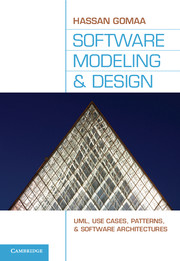Software Modeling and Design
This book covers all you need to know to model and design software applications from use cases to software architectures in UML and shows how to apply the COMET UML-based modeling and design method to real-world problems. The author describes architectural patterns for various architectures, such as broker, discovery, and transaction patterns for service-oriented architectures, and addresses software quality attributes including maintainability, modifiability, testability, traceability, scalability, reusability, performance, availability, and security.
Complete case studies illustrate design issues for different software architectures: a banking system for client/server architecture, an online shopping system for service-oriented architecture, an emergency monitoring system for component-based software architecture, and an automated guided vehicle for real-time software architecture.
Organized as an introduction followed by several short, self-contained chapters, the book is perfect for senior undergraduate or graduate courses in software engineering and design, and for experienced software engineers wanting a quick reference at each stage of the analysis, design, and development of large-scale software systems.
- Provides a unified approach to designing software architectures, while describing the special considerations for each category of software architecture
- Presents case studies to appeal to readers who wish to design software architectures using a systematic UML-based method
Reviews & endorsements
"In Software Modeling and Design, Hassan Gomaa provides a clear, lucid presentation of a comprehensive software design method, based on industry-standard design notation, and battletested in the context of graduate-level software engineering courses taught at George Mason University. The book includes four, diverse case studies, showing readers how to apply the method to solve industrial-scale software design problems. These traits make this book unique within the field of software design and engineering."
Kevin Mills, NIST
“This book presents a general, complete, and precise engineering solution, illustrated by many thorough examples, for model-based architecture and design. I strongly recommend it to anybody who wants to teach, or get acquainted with, the practice of modeling software.
Beyond notation, this book focuses on fundamental and practical modeling and architecting principles."
Lionel Briand, Simula Research Laboratory and University of Oslo
"This is a ‘must have’ book for any senior technologist actively involved in the software development life cycle. It provides not only principles of software architecture, design and development but also practical examples of how to apply these techniques to produce high-quality, maintainable and extensible software. Dr. Gomaa, a recognized thought leader in software engineering, hits another home run with this volume."
Mark Gianturco, Intelligent Discovery Solutions
"Software modeling and designing are complex activities. Developing high quality models, particularly by novice analysts, requires a thorough understanding of the fundamentals of modeling as well as its nuances. This book provides a comprehensive coverage of modeling the static and dynamic aspects of software systems and architectures. It presents a fresh perspective on software modeling and design through the application of the UML based COMET (Collaborative Object Modeling and Architectural Design Method) approach to real world examples. Dr Gomaa has done an excellent job of presenting the material in a simple and elegant manner. The fundamental concepts have been explained with lots of examples and further solidified through several case studies presented at the end of the book. Overall, this is an excellent book on software modeling and design that will be valuable for not only software engineering students but also practitioners."
Vijayan Sugumaran, Oakland University, Rochester, Michigan
"Software modeling continues to dominate as a method of choice for practitioners to gain an in-depth understanding of complex systems. Gomaa's book stands out from other titles on software modeling in both its breadth and depth of coverage. Its detailed case studies are second to none when it comes to really seeing how modeling can be applied in practice."
Jon Whittle, Lancaster University
"The COMET method is a unique UML-based approach covering theories and practices for modeling and design of software systems. This book is the core of author’s experiences and philosophy on software development."
Michael Shin, Texas Tech University
"This is a large book with interesting, well-presented material; it is particularly strong in its wealth of examples, as well as its discussion of concurrency, which permeates the book. It is a strong contender for adoption as the textbook in advanced undergraduate and graduate courses in object-oriented analysis and design, particularly when architectural design is the focus. Practitioners will also find it to be a useful tutorial and reference."
Christopher Fox, Computing Reviews
"Software Modeling and Design is well written and concise, effectively describing a variety of software models and architectures. Gomaa has served in industry and academia; his research revolves around this book's topic, and he has made numerous contributions in the field. Possibly the best part of the book can be found toward the end, where the author presents a series of case studies."
D. Papamichail, Choice Magazine
Product details
March 2011Adobe eBook Reader
9781139036740
0 pages
0kg
344 b/w illus.
This ISBN is for an eBook version which is distributed on our behalf by a third party.
Table of Contents
- Part I. Overview:
- 1. Introduction
- 2. Overview of UML notation
- 3. Software life cycles and processes
- 4. Software design and architecture concepts
- 5. Overview of software modeling and design method
- Part II. Software Modeling:
- 6. Use case modeling
- 7. Static modeling
- 8. Object and class structuring
- 9. Dynamic interaction modeling
- 10. Finite state machines and statecharts
- 11. State-dependent dynamic interaction modeling
- Part III. Architectural Design:
- 12. Overview of software architecture
- 13. Software subsystem architectural design
- 14. Designing object-oriented software architectures
- 15. Designing client/server software architectures
- 16. Designing service-oriented architectures
- 17. Designing component-based software architectures
- 18. Designing concurrent and real-time software architectures
- 19. Designing software product line architectures
- 20. Software quality attributes
- Part IV. Case Studies:
- 21. Client/server software architecture case study: banking system
- 22. Service-oriented architecture case study: online shopping system
- 23. Component-based software architecture case study: emergency monitoring system
- 24. Real-time software architecture case study: automated guided vehicle system
- Appendix A: catalog of software architectural patterns.






